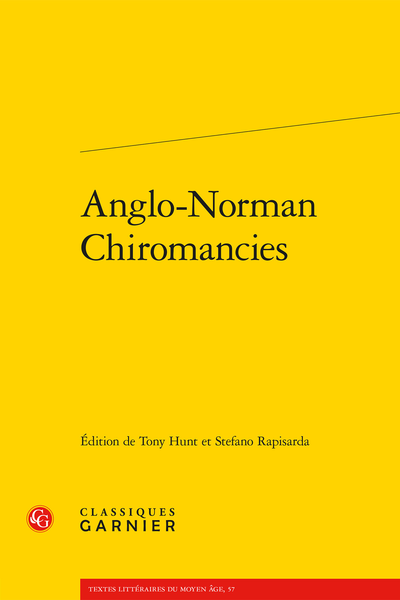
Selected glossary of technical terms
- Type de publication : Chapitre d’ouvrage
- Ouvrage : Anglo-Norman Chiromancies
- Pages : 91 à 92
- Collection : Textes littéraires du Moyen Âge, n° 57
- Série : Divinatoria, n° 7
- Thème CLIL : 3438 -- LITTÉRATURE GÉNÉRALE -- Oeuvres classiques -- Moyen Age
- EAN : 9782406097235
- ISBN : 978-2-406-09723-5
- ISSN : 2261-0804
- DOI : 10.15122/isbn.978-2-406-09723-5.p.0091
- Éditeur : Classiques Garnier
- Mise en ligne : 12/10/2020
- Langue : Anglais
Selected glossary
of technical terms
Reference numbers in square brackets refer to sections of the relevant texts whose titles are abbreviated as follows: Chiromantia parva = Cp; Chiromantia in the Eadwine Psalter = Ce; Main de home = Mh; Main de femme = Mf; Palmistria Salomonis = Ps; quotations from Isidore of Seville are drawn from Isidori Hispalensis Episcopi, Etymologiarum sive Originum libri viginti XI,1, recognovit brevique adnotatione critica instruxit W.M. Lindsay, Oxford 1911, vol. II, p. 1182.
accidenteles: see lignes accidenteles
angle: the three natural lines on the palm of each hand which make up a triangle, namely sovereins angles ‘upper angle’, angle plus basse en destre ‘lower right angle’ and terz angle ‘lower left angle’, see Cp[12-14]
auriculere (deit): the fifth, or little finger, frequently used to scratch the ear, see Isidore, Etymologiae XI 1.72: “Quintus auricularis, pro eo quod eo aurem scalpimus.”, see Cp[30]
auriculere (ligne): see ligne auriculere
coing: < lat. cono, the mount (raised portion of flesh) of the thumb which together with the outer edge of the palm closes the concave part of the palm in which is inscribed the triangle, see Cp[34]
chef: The end of a line as opposed to its root, see racine
coste: the outer edge of the palm, or acumen, the fleshy part of the hand uniting the palm and back of the hand with which one strikes blows
demostrour/demostrer/demostrur/demestror: index finger, according to Isidore used to indicate, Etymologiae XI,1.70 “Secundus index et salutaris seu demonstratorius, quia eo fere salutamus vel ostendimus”, see Cp[24]
decrevesce: a short, broken line, translating Lat. rimula and, in some texts, virgule, see Cp[18] ms D
destre: see ligne destre
eu[ri]gleus: little finger, see Mh[3]
figure: a visible sign in various parts of the hand or inscribed in a drawing of the lines of a hand, such as a star, a cross, a circle, a rhombus, or a dot, sometimes accompanied by letters and numbers
instance: judgement, see Cp[40]
leyse: breadth, see Ce[7]
lignes accidenteles: lines which have no significance for iudicia, being generated by ‘accidental’ or ‘extrinsic’
92factors such as cold, heat, manual labour etc., see Cp[6]
ligne auriculere / auriculiere: a line that stands at the base of the little finger, see Cp[30, 31]
ligne destre: the righthand line of the triangle, one of the three ‘natural’ lines
ligne mensele: the mensal – or table-line, ‘line of Fortune’, which runs above the triangle across the length of the table of the hand. It begins at the outer edge of the palm or beneath the little finger, here also called ligne tabilouse. see Wartburg, FEW VI,i 711a (1549)
lignes natureles: The three lines composing the triangle, namely the destre ligne, the soveregne ligne and the ligne plus basse, together with the ligne mensele or ligne tabilouse. They are present in every man’s or woman’s hand and are very relevant to the judicium, see Cp[1], [4]
lignes natureles et accidenteles: The presence of these lines varies from person to person and is relevant to the judgement, see Cp[5]
ligne plus haute: also called soveregne ligne, is the upper line of the triangle, one of the three ‘natural’ lines
ligne plus basse: the lower line of the triangle, also one of the three ‘natural’ lines
men dey / mein dei / meyn dey / maien dey: the third finger or digitum medium, also called impudicus, see Isidore of Seville, Etymologiae XI 1, 71: “Tertius impudicus, quod plerumque per eum probri insectatio exprimitur”, see Cp[27]
mensa: the area between the mensal-line and the triangle, which in some texts seems to more or less correspond to the table of the hand, though no precise measurement is given
mensele: see ligne mensele
natureles: see lignes natureles
natureles et accidenteles: see lignes natureles et accidenteles
ongle: nail, see Cp[36], [38]
paume: the palm of the hand (Lat. planities)
pertus: translates Lat. foramen, ‘hole, opening’ see Cp[43] and pertusees ‘pierced’, Cp[3]
poucier/pocier: thumb. The first finger takes its name from its being considered the preeminent finger, see Isidore, Etymologiae XI 1. 70: “Primus pollex vocatus, eo quod inter ceteros polleat virtute et potestate”, see Cp[34], Ce[16]
racine: the root of the finger, the point at which the finger meets the bones of the hand; 2. The end of a line as opposed to chef
sovereine / soveregne ligne: one of the three natural lines, also sovereyne naturele, Ce[9]
table: translating Lat. mensa, also used to indicate the area of the hand which lies between the median line and the table-line, table mensele Cp[30]
tabilouse (ligne), tablose: the linea mensalis, because it crosses longitudinally the table. In other chiromantic texts it is also called the ‘median’, see Cp[1], [4], [8]
triaungle/treaungle/treangle/tryangle: the triangle composed by the three natural lines, viz. the sovereine ligne, the ligne destre and the ligne plus basse